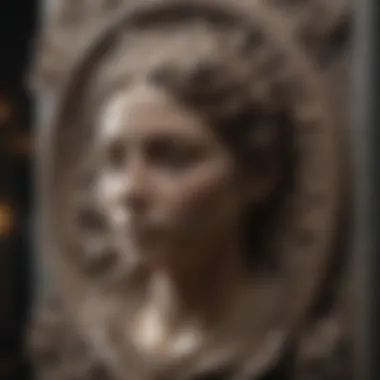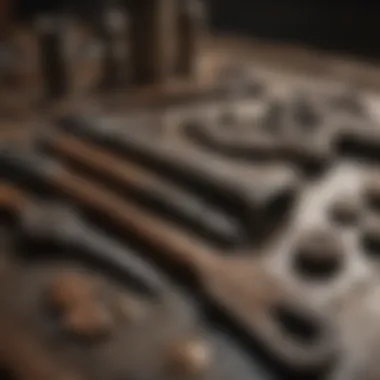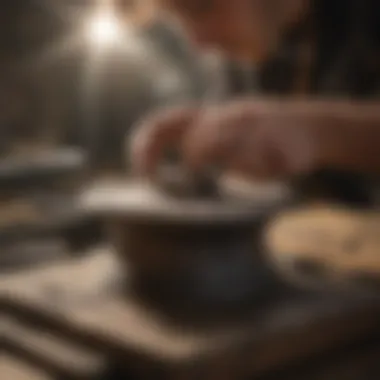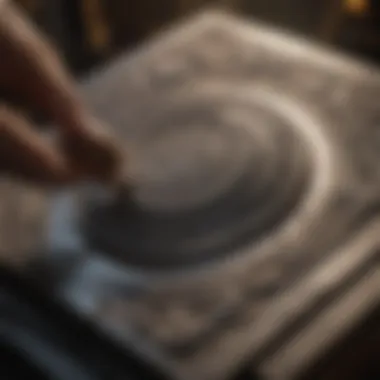Mastering the Art of Cast Mold Creation: A Comprehensive Guide


Rock Identification
In the realm of cast mold making, understanding the types of rocks utilized is essential for achieving accurate replicas. Different kinds of rocks possess varying characteristics that influence the molding process. Identifying the appropriate rock type ensures the durability and quality of the cast mold. Therefore, recognizing the difference between igneous, sedimentary, and metamorphic rocks is crucial. Familiarity with the specific features of each rock type equips creators with the knowledge needed to select the most suitable material for their cast mold projects. Furthermore, exploring the tools required for rock identification enhances the precision and detail of the molding process.
Fossil Identification
In the intricate art of cast mold making, fossils play a significant role in replicating historical artifacts. Recognizing different types of fossils and their unique characteristics is fundamental to producing accurate molds. From trace fossils to body fossils, each category presents distinct challenges and opportunities for creators. Learning to distinguish between various fossil types and understanding their formation processes enriches the knowledge base of individuals immersed in cast molding. Additionally, acquiring a comprehensive set of tools for fossil identification enables artisanal precision and authenticity in replicating fossil specimens.
Tools for Identification
Utilizing the appropriate tools in rock and fossil identification is paramount for successful cast mold creation. Magnifying glasses, chisels, hammers, and brushes are essential instruments that aid in accurate identification of rock and fossil specimens. Employing these tools allows for detailed examination of surface textures, color variations, and structural properties of rocks and fossils. Moreover, advanced technologies such as UV light and spectroscopy provide deeper insights into the composition and characteristics of specimens, enhancing the accuracy of cast mold replication. Aspiring cast mold makers can elevate their craft by mastering the use of these tools and techniques in rock and fossil identification.
Introduction
In the realm of craftsmanship and precision lies the intricate art of making a cast mold. This introductory section serves as the gateway to a realm where the replication of objects transcends mere imitation to become an art form. Readers delving into this article will embark on a journey of understanding the depth and skill required to master the art of creating cast molds.
Cast molds are indispensable tools in various industries and artistic domains, playing a pivotal role in preserving artifacts and replicating objects for display or functional purposes. The significance of cast mold making is not just limited to replication but extends to the artistry of accurately capturing the essence and details of the original object.
As we progress through this article, we will unravel the complexities and nuances of cast mold making, shedding light on the processes, techniques, and materials essential for achieving exceptional results in replicating a diverse range of objects.
Definition of Cast Mold
Understanding the Concept
In the realm of cast mold making, understanding the concept holds paramount importance. The concept entails creating a negative impression of an object that allows for the precise reproduction of its details. This meticulous process involves capturing even the minute intricacies of the original object, ensuring that the replica mirrors the exact shape and texture.
Applications in Various Industries
The applications of cast molds span across a multitude of industries, from art and design to manufacturing and restoration. Utilized in sculpting, prop-making, and restoration work, cast molds offer artisans and craftsmen a versatile method of replicating complex shapes and textures with exceptional accuracy.
When considering cast molds for various industries, the versatility and repeatability they offer make them a preferred choice. The ability to reproduce intricate details consistently aids in creating multiple replicas with consistency, making them invaluable tools for artists, archaeologists, and manufacturers alike.
Significance of Cast Molds
Preservation of Artifacts
Preservation of artifacts through cast mold making enables the replication of historical and archaeological pieces with precision and fidelity. By creating accurate replicas, the originals can be safeguarded in controlled environments while allowing for detailed study and public display of the replicas.
Replication for Display Purposes
Replication for display purposes serves as a bridge between preserving the past and engaging the present audience. Whether in museums, galleries, or educational institutions, replicated objects offer viewers the opportunity to experience and appreciate art and history up close, fostering a deeper connection to cultural heritage.


Overview of the Process
Basic Steps Involved
The process of cast mold making entails a series of fundamental steps that form the foundation of replicating objects with precision. From preparing the object and creating the mold to casting and finishing touches, each step is crucial in ensuring the quality and accuracy of the final replica.
By understanding the basic steps involved in cast mold making, individuals can grasp the complexities and attention to detail required in mastering this art form. Attention to detail, precision in mixing materials, and careful demolding techniques are all essential components that contribute to the success of creating a flawless cast mold.
Materials Required
In the intricate art of making a cast mold, the selection of materials plays a pivotal role in achieving precise replication. Understanding the materials required is crucial for creating accurate replicas, making this aspect a fundamental focus of this guide. The importance of materials lies in their ability to influence the quality and detail of the final mold, making informed choices critical for success.
Silicone Rubber
Types and Properties
When delving into the realm of cast mold making, the types and properties of silicone rubber are paramount considerations. Silicone rubber offers a diverse range of options, each with unique characteristics contributing to the overall efficacy of the molding process. The key characteristic of silicone rubber lies in its flexibility and durability, vital for capturing intricate details of objects. Its soft and pliable nature allows for easy removal from delicate molds, making it a popular choice among craftsmen and artisans. Additionally, the high tear strength and resistance to elements make silicone rubber a reliable option for creating durable and long-lasting molds. However, one potential disadvantage is its relatively higher cost compared to other mold-making materials, yet the benefits in terms of quality and longevity often justify the investment.
Casting Resin
In the sphere of casting molds, the varieties and applications of casting resin offer a wide array of possibilities for creators. Understanding the diverse options available is essential for selecting the most suitable resin for specific molding projects. Casting resin, known for its clarity and fast curing times, provides an ideal medium for capturing fine details and producing intricate replicas. The key characteristic of casting resin is its viscosity and self-leveling properties, ensuring smooth and bubble-free castings. Its versatility in accommodating various pigments and additives further expands the creative possibilities for artisans. However, some variations may have longer curing times or emit strong odors during the curing process, requiring adequate ventilation for safety measures.
Release Agents
Release agents are indispensable components in the mold-making process, facilitating the easy removal of casts without damaging the molds. Their importance lies in preventing adhesion between the mold and the casting material, ensuring seamless demolding procedures. Selecting the appropriate release agent is crucial for preventing mold degradation and preserving the quality of the replicas. The key characteristic of release agents is their compatibility with different mold materials and casting resins, offering a smooth and efficient release process. Their usage extends beyond traditional mold making, finding applications in various industries where mold release is a necessity. However, improper application or overuse of release agents can result in surface defects or interference with subsequent finishing treatments, emphasizing the need for precision and care in their usage.
Preparing the Object
In the realm of cast mold making, the preparation of the object serves as a foundational step that significantly impacts the quality and accuracy of the final replica. This section delves into the critical aspects of preparing the object and sheds light on its paramount importance throughout the casting process. By meticulously cleaning and securing the object before creating the mold, artisans ensure that the resulting replica captures every intricate detail with precision and finesse.
Cleaning and Securing
Ensuring Surface Quality
When it comes to creating a cast mold, the meticulous attention to ensuring surface quality plays a pivotal role in the replication process. By meticulously cleaning the surface of the object to be molded, artisans eliminate any imperfections or contaminants that could compromise the fidelity of the final product. Additionally, securing the object in place ensures that it maintains the desired position during the molding process, facilitating the accurate transfer of details onto the mold.
The key characteristic of ensuring surface quality lies in its ability to enhance the overall clarity and definition of the mold. This meticulous process allows artisans to capture even the smallest nuances and textures present on the object's surface, resulting in a faithful replica that mirrors the original object with remarkable accuracy. The meticulous nature of ensuring surface quality makes it a preferred choice for artisans seeking to create flawless cast molds that showcase the intricacy of the object being replicated.
The unique feature of ensuring surface quality lies in its ability to act as a quality control measure that mitigates any potential errors or imperfections during the molding process. By focusing on surface cleanliness and uniformity, artisans can ensure that the mold accurately captures all the details of the object, creating a high-quality replica that reflects the craftsmanship and dedication invested in the mold-making process.
Creating a Mold Box


The creation of a mold box represents a crucial step in the mold-making process, serving as the containment unit that encapsulates the object and the mold material. Through enclosing the object within a mold box, artisans create a controlled environment that facilitates the molding process and ensures the integrity of the mold.
The key characteristic of creating a mold box lies in its ability to provide a secure and stable environment for the mold-making process. By constructing a sturdy and properly sealed mold box, artisans prevent any leaks or distortions that could compromise the mold's structure or detail. This containment method allows for precise molding outcomes and minimizes the risk of any external factors affecting the mold.
The unique feature of creating a mold box is its versatility in accommodating objects of varying sizes and shapes for molding. Whether dealing with small, intricate artifacts or larger objects, a well-designed mold box can adapt to different scenarios, offering flexibility and convenience in the mold-making process. However, artisans should be mindful of potential disadvantages such as material costs and the time required to construct a custom mold box.
Casting Process
In the realm of creating cast molds, the Casting Process stands as a pivotal stage that dictates the accuracy and quality of the final replica. This section serves as a guiding beacon for individuals delving into the world of cast molding, shedding light on the intricacies and importance of the process. The Casting Process outlines the meticulous steps involved in transforming a mold into a precise replica, showcasing the craftsmanship and attention to detail required in this art form.
The Casting Process delineates the foundation on which the entire replication endeavor rests. It is the stage where the magic of transforming materials into a faithful facsimile of the original object takes place. Without a robust and meticulous Casting Process, achieving a flawless replica becomes a herculean task, making this section a cornerstone of this comprehensive guide.
Mixing and Pouring
In the hierarchy of the Casting Process, Mixing and Pouring emerge as fundamental elements that can make or break the final outcome of the cast mold. This subsection explores the nuances of Mixing and Pouring, emphasizing the significance of precision and accuracy in this critical stage.
Ensuring Precision
Within the realm of Mixing and Pouring, Ensuring Precision stands as a paramount facet that underpins the entire process. Precision in measurements and mixing proportions is crucial to achieving a flawless cast mold devoid of imperfections. The key characteristic of Ensuring Precision lies in its ability to guarantee the exact replication of the object, down to the minutest details.
Ensuring Precision is a popular choice for this article due to its indispensable role in producing high-quality cast molds. By meticulously following precise measurements and mixing techniques, artisans can create replicas that mirror the original object with utmost fidelity. The unique feature of Ensuring Precision lies in its ability to eliminate inconsistencies and irregularities, ensuring that each cast mold is an exact replica of the source material.
Careful Removal Steps
Another pivotal aspect of the Casting Process is Demolding Techniques, with Careful Removal Steps being a crucial component that dictates the success of the endeavor. This subsection delves into the meticulous process of demolding, highlighting the essential steps required to extract the replica without causing any damage.
Careful Removal Steps play a significant role in safeguarding the integrity of the cast mold. By employing precise techniques and gentle handling, artisans can ensure that the replica is retrieved intact and without any deformities. The key characteristic of Careful Removal Steps lies in its ability to preserve the intricate details of the mold during the demolding process, guaranteeing a flawless final product.
Careful Removal Steps are a popular choice for this article due to their transformative impact on the final outcome of the cast mold. By mastering the art of demolding with care and precision, artisans can elevate their creations to a level of unparalleled excellence. The unique feature of Careful Removal Steps lies in their ability to protect the delicacy of the mold, preserving every nuance and intricacy captured during the casting process.
Finishing Touches
Finishing touches play a crucial role in the mastery of creating a cast mold. In this article, we emphasize the significance of this final stage in the reproduction process. Everything from trimming and sanding to painting and detailing contributes to the overall quality and accuracy of the final replica. By focusing on these specific elements, artisans can ensure that their cast molds replicate the original object with precision and authenticity.
Trimming and Sanding
Trimming and sanding are essential steps in achieving smooth edges for the cast mold. Proponents of this technique understand the value it brings to the final product by refining rough surfaces and eliminating imperfections. The key characteristic of achieving smooth edges lies in the attention to detail and craftsmanship involved. By investing time in precise trimming and sanding, artisans can enhance the visual appeal and accuracy of their replicas to meet exacting standards expected in cast mold making. The advantages of this meticulous approach include improved aesthetics, increased durability, and better overall quality in the finished piece.
Painting and Detailing
The process of painting and detailing is vital in enhancing the replica created through cast molding. This aspect adds depth, realism, and intricate details to the final piece, ensuring it captures the essence of the original object. Artists often choose to focus on painting and detailing to elevate the visual impact of their cast molds. The key characteristic of enhancing the replica through painting and detailing is the ability to bring out textures, colors, and nuances that make the replica lifelike and captivating. This choice is popular in the realm of cast mold making for its ability to transform a plain replication into a work of art. The unique feature of painting and detailing is its customizable nature, allowing artisans to tailor the finish to their preferences, thereby creating distinct and personalized replicas.


Advanced Techniques
Multi-Part Molding
Multi-part molding is a sophisticated approach that enables artisans to capture even the most complex shapes and structures with remarkable accuracy. By breaking down the mold into multiple components, craftsmen can reproduce intricate details and textures that would be challenging to achieve in a single-piece mold. This method is especially beneficial when dealing with objects that have intricate designs or intricate geometries.
Complex Mold Structures
The key characteristic of complex mold structures lies in their ability to capture intricate details and elaborate shapes with unparalleled fidelity. These molds are meticulously crafted to ensure that every nook and cranny of the original object is faithfully replicated in the final cast. The intricate nature of complex mold structures makes them a popular choice for artisans seeking to create highly detailed and lifelike replicas.
Cold Cast Metal Effects
Cold cast metal effects add a touch of sophistication and realism to cast molds, mimicking the appearance and texture of metal surfaces with astounding accuracy. This technique is favored for its ability to create stunning metallic finishes that enhance the visual appeal of the replicas. By utilizing cold cast metal effects, artisans can transform ordinary molds into striking pieces of art that exude elegance and refinement.
Creating Metallic Finishes
The hallmark of creating metallic finishes is its ability to replicate the luster and sheen of metal surfaces, bringing a sense of authenticity to the cast molds. This technique enhances the overall aesthetic appeal of the replicas, making them visually compelling and captivating. Artisans appreciate the versatility of creating metallic finishes, as it allows them to experiment with different metal colors and textures to achieve the desired look and feel.
Transparent Casting
Transparent casting opens up a world of possibilities for artisans, allowing them to create crystal-clear replicas that showcase the finest details of the original objects. This technique is ideal for objects with transparent or translucent properties, such as gemstones or glass sculptures. By mastering transparent casting, artisans can produce stunning replicas that highlight the beauty and intricacy of the enclosed objects.
Achieving Crystal Clear Results
The hallmark of achieving crystal clear results is the ability to create flawless, bubble-free casts that exhibit exceptional clarity and brilliance. This unique feature of transparent casting allows artisans to showcase the intricate details and textures of the original objects with unparalleled transparency. While transparent casting offers superb visual results, artisans must carefully manage the curing process to avoid potential challenges such as air bubbles or cloudiness in the final cast.
Troubleshooting and Tips
This section on Troubleshooting and Tips is of paramount importance within the realm of mastering the craft of making cast molds. It serves as a guiding beacon for individuals looking to navigate the complexities of cast molding, offering invaluable insights and strategies to overcome challenges effectively. By delving into common issues and expert recommendations, this section equips readers with the tools needed to elevate their casting skills and achieve superior results. In the intricate world of cast molding, troubleshooting plays a crucial role in ensuring the accuracy and quality of the final replicas. With expert tips and troubleshooting techniques at their disposal, enthusiasts can tackle complexities with confidence and finesse, enhancing their proficiency in the art of creating molds.
Conclusion
Craftsmanship and precision stand as the pillars of success in the world of cast mold making. The meticulous attention paid to every detail, the finesse with which each step is executed, and the unwavering commitment to excellence define the essence of this art form. Craftsmanship underscores the artisanal skill and devotion poured into each mold, while precision ensures that every replica is an exact match to the original object.
Craftsmanship and precision are not merely tools used in cast mold making but rather beliefs embedded in the core of this practice. The fusion of skillful craftsmanship with unwavering precision results in flawless replicas that captivate the eye and mirror the intricate nuances of the original object. This commitment to perfection elevates the art of cast molding beyond a mere technique and transforms it into a testament to human ingenuity and artistry.
Achieving Perfection
Craftsmanship and Precision
Craftsmanship and Precision are the guiding principles that breathe life into the realm of cast mold making. Craftsmanship emphasizes an artisan's skill and dedication, showcasing a masterful blend of technique and passion. The meticulous process of creating a mold reflects the artisan's commitment to preserving the integrity of the original object.
Precision, on the other hand, ensures that each detail is captured with exactitude, leaving no room for error or deviation. The marriage of craftsmanship and precision results in replicas that not only mirror the physical attributes of the object but also encapsulate its spirit and essence. This seamless integration of skill and accuracy is what sets apart exceptional cast mold makers from the rest.
The key characteristic of craftsmanship and precision lies in the ability to transform a mundane object into a work of art. By infusing each mold with passion and meticulousness, artisans elevate their creations to a level of unparalleled beauty and authenticity. The intrinsic value of craftsmanship and precision lies in their capacity to transcend mere replication and evoke a sense of admiration and wonder.
Craftsmanship and precision are not just techniques; they are profound philosophies that shape the very essence of cast mold making. The unwavering dedication to excellence, the relentless pursuit of perfection, and the unwavering commitment to quality are the hallmarks of craftsmanship and precision in this art form. By embracing these principles, artisans can create molds that not only mirror reality but also transcend it, capturing the imagination and hearts of all who behold them.







